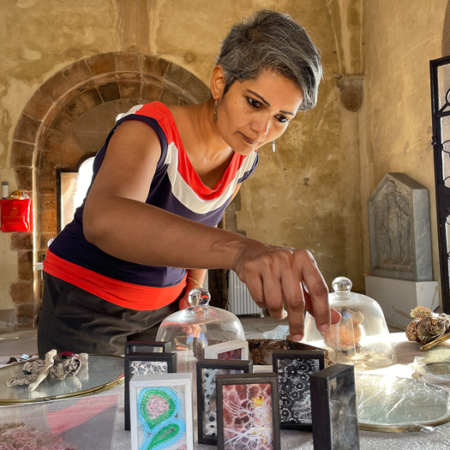Born in Chennai, India; Meera George hails from Kerala, South India. Alumni of Delhi college of Art and Kent Institute of Art & Design, UK; Meera predominantly works in mediums of Mixed media, installation and performance art that she exhibits internationally. Recipient of eight international grants and residencies, her work is sensitive to cross-cultural feminist issues, at the same time strongly autobiographical through the use of her own body and objects from her culture as actors and props in her works.
George’s recent mixed media artworks that comment on the impermanence of existence and climate change strike a delicate balance between material and concept. Vastly different from her performance art work, her meticulous mixed media artworks inspired by the fierceness of nature and its ability to accept everything in its fold without distinction, displays a different side to the artist’s practice.
An avid gardener and a nomad at heart, Meera George currently lives and works in Pune, India.
RELICS
The body of work titled ‘Relics’ explores through mediums and textures elements of the sea, partly viewed at a microscopic level. Washed up objects such as broken glass, corks, bottle caps and metal bits find their place next to driftwood, sea shells and sponges, serving as a gentle reminder of what our seas look like today.
The mixed media artworks find semblance with the microscopic structures of certain endangered species of plant and coral life of the Mediterranean. The work uses materials that are both natural and manmade lending a direct reflection to what the oceans offer. The arrangement of burnt paper, intertwined ribbon, pen work, alongside natural elements from the sea create little microcosms. Some material (such as kite paper) will naturally bleach over time commenting on the bleached coral reefs along the coast. Day to day objects that we take for granted, placed under perspex and cloches like specimens for closer clinical examination turn mundane into precious objects, some soon to be extinct. Emergence of new formations that juxtapose two worlds becomes the norm of the day.
The work comments on how the unnatural has camouflaged into the real and the benevolence of nature and the humility of the planet to accept everything in its fold without distinction. However the silent changes in biodiversity along the coasts is far from being unnoticed.
















